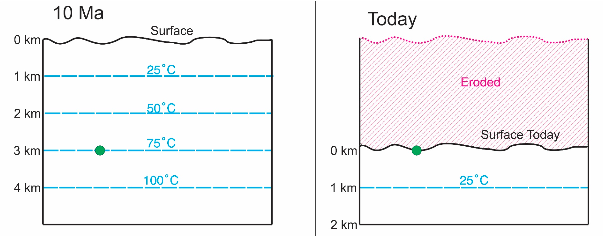The Grand Canyon is a dramatic topographic anomaly. Where does it come from? Dylan Vasey, a graduate student at the University of California-Davis presented on how geologists calculate the age of the Grand Canyon.
Overview
Problem: Nobody knows the exact age of the Grand Canyon.
Findings: The age of the canyon varies depending on how scientists interpret the data.
Conclusions: Although thermochronology (the study of dating the cooling of rocks) creates some confusion as to its exact age, ultimately scientists agree on the relative time scales it would take to form the Grand Canyon (millions of years, not thousands).
How did the Grand Canyon form?
To understand when the canyon formed, we need to have a sense of how the Grand Canyon formed.
The simplest answer is that the formation of the canyon is related to the formation of the Colorado Plateau, on which the Grand Canyon lies. The plateau formed when two tectonic plates collided along the western edge of North America –the same process that produced the Rocky Mountains. The crust beneath what is now the Pacific Ocean moved into North America. There, it was shoved under the continent (image below). In most cases, when this kind of movement (known as subduction) occurs, a coastal mountain range forms. However, in this case we observe the inland Rocky Mountain range. This is likely because the subducting crust flattened out beneath North America and pushed up the continent, forming the elevated Colorado Plateau.

Since water flows downstream from areas of high elevation to low elevation, water on the new plateau flooded the low elevated basins to the southwest. This flow of water is responsible for carving the Grand Canyon.
How do geologists age the Grand Canyon?
The temperature of rocks increases with depth below the Earth’s surface (seen in the image below). The process of carving out the Grand Canyon exposed rock that was previously below ground to Earth’s surface. These exposed rocks then cooled. Geologists can use patterns in the rocks and knowledge of underground temperatures to determine the time from when the rock cooled to the present. In doing so, they can estimate the time when the river carved out the canyon and exposed these rocks.

Geologists use knowledge of radioactive decay, the spontaneous transformation of a radioactive element, and the ratio of old to new material left behind from this process to estimate the time of cooling. This practice is known as thermochronology. In particular, they can use the mineral apatite. Apatite contains tiny amounts of the radioactive elements uranium and thorium, which produce helium as they decay. Since the helium is only kept in the rock if it has cooled below roughly 70 °C, the ratio of uranium and thorium (old material) to helium (new material) in the rock can provide the age of cooling.

The scientific dispute
There is some disagreement about how best to analyze this uranium-thorium to helium ratio (the ratio of old to new material). As a result, labs at the University of Colorado- Boulder and the University of New Mexico have different estimates for the age of the Grand Canyon. Both labs have calculated similar ages for their apatite, about 70-100 million years old, but their models for when the actual cooling happened don’t agree. This is because the Boulder model shows that cooling happened rapidly around 70 million years ago. However, the New Mexico model indicates a cooling event just before 70 million years ago and then another cooling period around 5-6 million years ago.
Why do the models disagree? One reason is that both lab groups are incorporating different additional data into their models besides the ratio of uranium-thorium to helium. How these other pieces of information are emphasized in the model can influence estimates. In addition, sample quality might be an issue, and the use of different samples at each lab could skew results.
So how old is it?
According to Vasey, the issue remains mostly unresolved, with the continuing emergence of scientific papers that provide support for both models. Vasey suggests that the best answer might be a combination of both estimates. That is, early canyons likely formed approximately 70 million years ago, but these were precursors to the modern Grand Canyon, which finished forming around 5-6 million years ago. The true disagreement lies in the resemblance between those early canyons and the Grand Canyon we see today.
Despite the contentious interpretation of this complicated data, there is no debate about the order of magnitude for the relative timing of the Grand Canyon’s formation. At the end of the day, scientists agree: it takes millions of years to form a structure of this magnitude.
